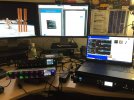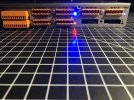I have performed some tests on a
Symetrix Radius AEC this is a sophistcated free form DSP with FIR capability upto 1024 tap filters. The fans on these units are tempreature controled blower fans so while not super annoying the cooling system would have to be modified for home use with the unit in the same room as the user. This unit has the specification THD + Noise < -94 dB, unweighted; 1 kHz @ +22 dBu with 0 dB gain, I'm presuming this is a loopthrough measurment (analog input directly connected to output). The unit also has 64x64 Dante digital audio IO but I will need to spend some time working out how to use that. The unit is specified to work with levels up to 23/24dBu (in/out).
For these tests I am using my
TASCAM US-2x2HR interface which achives SINAD (20-20kHz) 98.5dB in loopback at 4V output (note not much margin over these results better measurment equipment could show improved numbers).
4V input loopthrough line input 1 to output 1:
So we are hitting the spec here, SINAD is 4dB degraded compared to if I just connected the input of my interface to the output.
4V input loopthrough line AEC input 1 to output 5:
The AEC inputs have additional processing that can be used for acoustic echo cancelation, it can also be turned off to use them as normal inputs. The performance is the same as the line inputs.
Loop through frequency response and delay:
I'm not sure what kind of mad antialias filter they are using or if I'm seeing some strange alias effects but the attenuation at 24kHz is lower than it should be (kind of imposible to read due to the oscilations but around -30 to -60dB). LF corner is around 5Hz.
I think this is specified as 0.88 mS by the datasheet (sum input and output delays).
Inline attenuator on my soundcard input (~-14dB) 0dBfs internal signal generator (clip indicator on output red):
starting to clip here but not too bad.
Internal generator -2db (inline attenuator):
not clipping anymore.
Internal generator at 14dBu (no inline attenuator):
SINAD Is +2dB improved over using analog input.
Performance looks simlar to a drive rack PA2:
https://www.audiosciencereview.com/...riverack-pa2-speaker-management-system.14134/ in my view pretty decent with the performance reduction compared to gear that is normaly tested on ASR partly due to the capability to handle 24/23dBu signals (10dB more than typical for Hi-Fi gear). At home I use inline attenuators between my DSP and amplifier matching the amplifiers sensitivity to full scale output to reduce the output noise of the whole system.
 www.thevintageknob.org
www.thevintageknob.org


